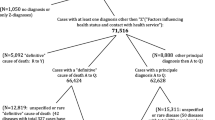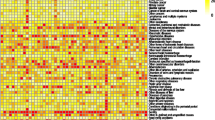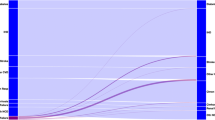Abstract
Cause-of-death statistics are a major source of information for epidemiological research or policy decisions. Information on the reliability of these statistics is important for interpreting trends in time or differences between populations. Variations in coding the underlying cause of death could hinder the attribution of observed differences to determinants of health. Therefore we studied the reliability of cause-of-death statistics in the Netherlands. We performed a double coding study. Death certificates from the month of May 2005 were coded again in 2007. Each death certificate was coded manually by four coders. Reliability was measured by calculating agreement between coders (intercoder agreement) and by calculating the consistency of each individual coder in time (intracoder agreement). Our analysis covered an amount of 10,833 death certificates. The intercoder agreement of four coders on the underlying cause of death was 78%. In 2.2% of the cases coders agreed on a change of the code assigned in 2005. The (mean) intracoder agreement of four coders was 89%. Agreement was associated with the specificity of the ICD-10 code (chapter, three digits, four digits), the age of the deceased, the number of coders and the number of diseases reported on the death certificate. The reliability of cause-of-death statistics turned out to be high (>90%) for major causes of death such as cancers and acute myocardial infarction. For chronic diseases, such as diabetes and renal insufficiency, reliability was low (<70%). The reliability of cause-of-death statistics varies by ICD-10 code/chapter. A statistical office should provide coders with (additional) rules for coding diseases with a low reliability and evaluate these rules regularly. Users of cause-of-death statistics should exercise caution when interpreting causes of death with a low reliability. Studies of reliability should take into account the number of coders involved and the number of codes on a death certificate.
Similar content being viewed by others
References
van Sonsbeek JLA. Van de schaduw des doods tot een licht ten leven. De historie van de methodiek van de doodsoorzakenstatistiek in Nederland 1865-2005. Voorburg/Heerlen: Centraal Bureau voor de statistiek; 2005.
Rosenberg HM. Cause-of-death as a contemporary problem. J Hist Med Allied Sci. 1999;54:133–53.
WHO. World Health Organisation. International Statistical Classification of Diseases and Related Health Problems. Tenth Revision. Geneva: WHO; 1992.
Franca E, de Abreu DX, Rao Ch, Lopez AD. Evaluation of cause-of-death statistics in Brazil, 2002–2004. Int J Epidemiol. 2008;37:891–901.
Anderson RN, Rosenberg HM. Disease classification: measuring the effect of the tenth revision of the International classification of diseases on cause-of-death data in the United States. Stat Med. 2003;22:1551–70.
Curb JD, Babcock C, Pressel S, Tung B, Remmington RD, Hawkins CM. Nosological coding of cause-of-death. Am J Epidemiol. 1983;118:122–8.
Chen L, Walker S, Tong S. The impact of the variation in death certification and coding practices on trends in mortality from ischaemic heart disease. Australian Health Review. 2002;25:189–96.
Treurniet HF, Boshuizen HC, Harteloh PPM. Avoidable mortality in Europe (1980–1997): a comparison of trends. J Epidemiol Communitry Health. 2004;58:290–5.
Parker MJ, Anand JK. What is the true mortality of hip fractures? Public Health. 1991;105:443–6.
Schade B. Reliability and validity of the classification of death in general practice. Scan J Prim Health Care. 1987;5:109–12.
Kircher T, Nelson J, Burdo H. The autopsy as a measure of accuracy of the death certificate. N Engl J Med. 1985;313:1263–9.
Brennan P, Silman A. Satistical methods for assessing observer variability in clinical measures. Br Med J. 1992;304:1491–4.
Boyle P, Parkin DM. Cancer registration: principles and methods. Statistical methods for registries. Lyon: IARC; 1991.
Maudsley G, Williams EMI. ‘Inaccuracy’ in death certification—where are we now? J Public Health Med. 1996;18:59–66.
Lu TH, Shou WY, Shih TP. Factors associated with errors in death certificate completion: a national study in Taiwan. J clin Epidemiology. 2001;54:232–8.
World Health Organisation (WHO). International statistical classification of diseases and related health problems. Tenth Revision, vol. 2. Geneva: WHO; 1993. p. 39.
National Centre for Health Statistics (NCHS). A methodological study of quality control procedures for mortality medical coding. DHEW Publications No. (PHS) 80-1355. Hyattsville: NCHS, 1980.
Leitner B. Control of coding in Austria. Luxembourg: Eurostat, TG-COD; 2006.
Giersiepen K, Greiser E. Verschlüsselung von Todesursachen fur Mortalitätsstatistieken–Vergleich von Signierergebnissen in verschiedenen statistischen Aemtern der Bundesrepublik Deutschland und West-Berlins. Oeffentliche Gesundh.-Wes. 1989;51:40–7.
Winkler V, Ott JJ, Becher H. Reliability of coding causes of death with ICD-10 in Germany. Int J Public Health. 2010;55:43–8.
National Board of Health and Welfare (Sweden). Dödsorsaker 2006. Stockholm: Statistics Sweden, 2006.
Minder ChE. Zur Qualität der Schlüsselung der Todesursachen in der Schweiz. Sozial-und Präventivmedizin. 1984;29:248–50.
Lu TH, Lee MC, Chou MC. Accuracy of cause-of-death coding in Taiwan: types of miscoding and effect on motality statistics. Int J Epidemiol. 2000;29:336–43.
Birch D. Automatic coding of causes of death. Popul Trends. 1993;15:53–6.
Lu TH. Using ACME software to monitor and improve the quality of death statistics. J Epidemiology Community Health. 2003;57:470–3.
Th Lu, Tsau SM, Wu TC. The automated classification of medical entities (ACME) system objectively assessed the approriateness of underlying cause-of-death certification and assignment. J Clin Epidemiol. 2005;58:1277–81.
Pavillon G, Coleman M, Johansson LA, Jougla E, Kardaun J. Coding of causes of death in European community. Luxembourg: Eurostat; 1998 (report 96/S 99-57617/EN).
Acknowledgments
We would like to thank the four coders of Statistics Netherlands for their participation in this study. We thank Onno van Hilten and the staff members of Health Statistics for their critical comments on earlier drafts of this paper.
Author information
Authors and Affiliations
Corresponding author
Rights and permissions
About this article
Cite this article
Harteloh, P., de Bruin, K. & Kardaun, J. The reliability of cause-of-death coding in The Netherlands. Eur J Epidemiol 25, 531–538 (2010). https://doi.org/10.1007/s10654-010-9445-5
Received:
Accepted:
Published:
Issue Date:
DOI: https://doi.org/10.1007/s10654-010-9445-5




